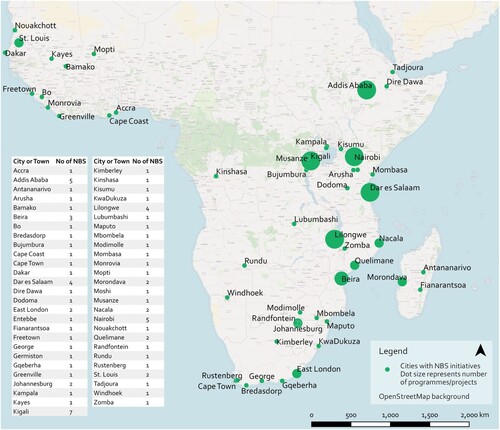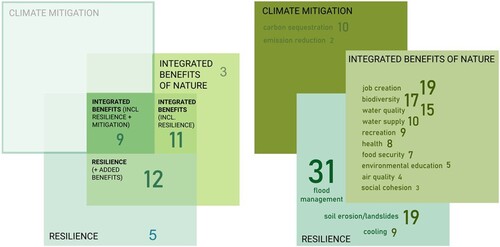Figures & data
Figure 1. Location of NBS initiatives with transnational actor involvement in the dataset. Note: The map indicates the distribution of identified NBS-related programmes and projects with a concentration in Eastern and Southern Africa. Whilst the dataset contains information on initiatives in 57 cities, some projects had not yet identified the names of target cities, hence the map contains a lesser number of cities. In South Africa, the ICLEI LAB Wetlands project covered District Municipalities which include a larger number of local municipalities. For visualisation, the town or city that hosts the seat of the District Municipality is shown.

Table 1. Overview of main transnational actors in the dataset and the respective deployed frames of urban nature in Africa.
Figure 2. Main frames of urban nature in the African context and related issues addressed. Note: On the left, the main frames identified in the dataset are visualised. This shows a clear nexus between “nature for resilience” and “integrated benefits” in terms of the overlaps and combinations of frames as depicted in the centre of the figure. While the resilience frame dominates in 17 projects, 12 of these have also included additional benefits. The example outlined in the methodology section of this paper (a project focusing on wetland management to address flood protection, which seeks to improve water quality as a secondary or additional benefit) falls in this category. The “integrated benefits” frame dominates in a total number of 23 projects. In 11 of these, resilience or adaptation-related goals are included, while nine include both resilience and mitigation. The latter is never advanced as a main objective itself but is always included as one of the many integrated benefits of nature. The visualisation on the right depicts the main issues advanced through these frames and how often these issues are featured. For example, flood management is the top issue, which 31 initiatives refer to (to varying degrees of emphasis).

